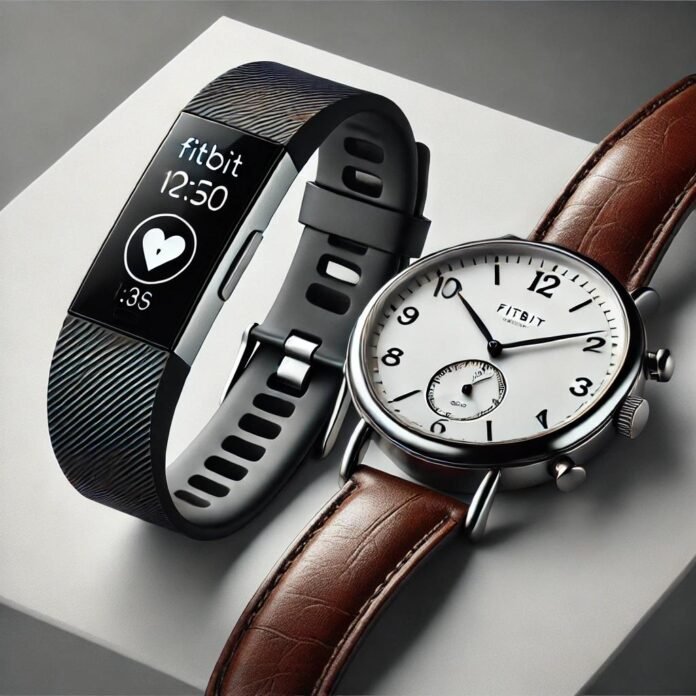intro
Wearable devices—which provide insights into our health, fitness, and connectivity—have become second nature in our daily lives in the technologically driven environment of today. Fitbits and smartwatches are two particularly well-liked devices among these ones. Although they seem alike, they satisfy diverse user demands and tastes. This page explores the differences between smartwatches and Fitbits so you may choose which wearable fits your way of living.
Dealing with Fitbits
Pioneer of the wearables, Fitbit mostly tracks health and fitness. Their products span from activity trackers to more sophisticated versions featuring smartwatch capabilities. Fitbits have important characteristics including:
- Tracking steps taken, distance travelled, calories burned, and active minutes helps one monitor activity.
- Continuous heart rate data from heart rate monitoring helps to guide a workout effectively.
- Track your sleep to get understanding of its quality and length.
- Exercise Recognition: From swimming to jogging, automatically finds and logs different exercises.
- With certain versions allowing contactless payments, smart features for calls, messages, and apps abound.
Investigating Smartwatches
Smartwatches are versatile tools that combine several smartphone capabilities into a wearable form outside of measuring fitness. Typical purposes are:
- Directly on the wrist, shows calls, texts, emails, and app alerts.
- From music streaming to navigation, app integration supports a great range of uses.
- Artificial intelligence assistants like Siri or Google Assistant are included for hands-free operation.
- Like fitness trackers, monitors health indicators; frequently with other capabilities like ECG readings.
- Customizing lets one match user tastes by using replaceable bands and unique watch faces.
Important Variances Between Smartwatches and Fitbits
1. Main Purpose
Designed with an eye toward health and fitness, Fitbits provide thorough understanding of physical activity and well-being.
Acting as an extension of cellphones, smartwatches offer a wider spectrum of capabilities together with fitness tracking.
2. Battery Life
Generally speaking, Fitbits have longer battery life—dependent on use—up to a week on one charge.
Given their many features, smartwatches usually need more frequent charging—often daily.
3. Compatibility
Fitbits give versatility across platforms and are compatible with both Android and iOS devices.
Smartwatches: Compatibility varies; Apple Watches are just iOS, while others like Samsung Galaxy Watches support both platforms.
4. Cost Point
Usually more reasonably priced, Fitbits vary in price depending on their characteristics from mid-range to budget.
Usually reflecting their increased capabilities and brand positioning, smartwatches are more expensive.
Selecting the Correct Tool for Your Purview
When choosing between a Fitbit and a smartwatch, weigh the following:
- Focus on Health and Fitness: A Fitbit would be more suited if your main objective is to track fitness activities and monitor health measures.
- Seamless Connectivity: A smartwatch would be helpful for individuals looking for flawless connection with smartphone capabilities including app access and communication functions.
- Budget Considerations: While smartwatches with their more extensive features come at a higher price range, Fitbits provide reasonably priced alternatives for tracking exercise.
Well-known Fitbit Models
- Fitbit Charge 6: Offering built-in Google apps, varied activity profiles, and accurate heart rate tracking, this is a dependable fitness tracker. It has a haptic side button and up to seven days’ worth of battery.
- Fitbit Versa 4: Combining smart features—call and text alerts—with fitness tracking, it supports Google Wallet and Google Maps.
- Fitbit Inspire 3: Designed for people new to fitness tracking or looking for a simple device, this entry-level tracker covers basic health stats.
Noteworthy Smartwatches
- Apple Watch Series 10: Presents a large range of apps, thorough health tracking, and flawless interface with iOS devices. It has great iOS integration and a brilliant always-on display.
- Samsung Galaxy Watch 7: Perfect for Android consumers, this watch offers strong fitness monitoring, Android compatibility, and access to lots of apps.
- Garmin Venu 3: Designed with enhanced health metrics, GPS capability, and outstanding battery life, it appeals to fitness buffs.
Often Asked Questions
READ ABOUT-Gabb Watch: The Ultimate Smartwatch for Kids’ Safety and Connectivity
1. Can I use a Fitbit connected via my smartphone?
Indeed, Fitbits let data be synced via the Fitbit app using both Android and iOS smartphones.
2. Do smartwatches provide Fitbits’ equivalent of fitness monitoring capabilities?
Indeed, most smartwatches have fitness monitoring features; yet, the depth and accuracy may vary from those of specialized fitness trackers like Fitbits.
3. How often do I have to charge these devices?
Fitbits usually need to be charged every five to seven days; smartwatches, on the other hand, usually need daily charging given their several functions.
4. Exists a membership cost for Fitbits or smartwatches?
While smartwatches may need app subscriptions for some features, Fitbit provides a premium membership for advanced insights; basic functionality remains free.
5. For working out, which is better—a Fitbit or a smartwatch?
Fitbits are ideal for committed workout monitoring since they are especially meant for tracking fitness. Smartwatches with fitness monitoring capability, however, also provide useful features—especially for those looking for multifarious use.
In Summary
Your priorities, way of life, and budget will determine if a Fitbit or a smartwatch suits you. Should your primary focus be on fitness tracking, a Fitbit could be the perfect tool. On the other hand, a smartwatch might be a better choice if you wish for a gadget that easily connects with your smartphone and provides a larger spectrum of uses. Whatever your decision, both choices provide useful qualities to improve your daily living and welfare.



